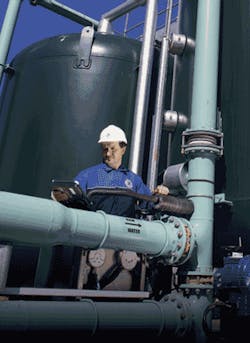Building Bridges between Islands
by Thell Gillis
• Key factors to consider when deploying mobile and wireless devices to assist business process automation in the wastewater industry
Many water and wastewater organizations are beginning to look to mobile technology as a means to improve operations. The goal of any technology purchase should be that tools deployed actually increase employee efficiency in the field and streamline communications between office workers and the fleet – whether connecting multiple facilities, vehicles or the shop floor and head office within a large industrial plant or utility.
This article, however, points out that, unless careful considerations are addressed in the evaluation process, success is far from guaranteed.
Islands in the Stream
Many mobile workers encounter an "isolated island" syndrome: Once out of the office, their ability to effectively communicate with other fieldworkers and headquarters can be limited without suitable tools enabling them to provide and gather crucial information about job status or equipment location in real-time. Technology can play a role in these bridging islands, making the flow of information seamless.
This challenge can't be tackled effectively without first asking key questions about expectations your organization has of a planned mobile and wireless solution. This includes:
- Where and when does this solution need to work?
- What tasks will be completed using this technology?
- How harsh is the work environment?
- Does information need to be captured and sent in real-time?
- Who will be using the technology?
The purpose of these (and other) questions is to ensure project managers and IT work together – with employees in the field – to identify and deliver a solution tailored to what's expected of it. All too often projects fail due to decisions made from afar, resulting in the deployment of technology that falls short of the goals expected of it.
Where is Your Fleet?
When determining the right mobile tool for the fleet, project managers and IT decision makers are faced with a complicated task, as there's no product that suits every work environment. And when the technology deployed in the field isn't optimized for harsh working environments, it leads to frequent hardware failures, decreasing employee efficiency and increasing down-time. This is why for certain tasks rugged mobile computers have gained popularity.
Still, even when evaluating rugged PCs, it's important to note distinctions between levels of "rugged." There's a range of products available on the market today making claims about durability and reliability. This is because the rise of wireless technology options has created a workforce increasingly on the move. Of course, a computer on the move is automatically at a higher risk of damage than one that sits at desk.
Fully-, semi- and business-rugged computing solutions in a variety of shapes and sizes – from ultra-mobile personal computers (UMPCs) to full-form factor desktop replacements – have evolved to address a range of user environments and requirements. If your technicians ever operate in harsh conditions such as rain, snow, dirt, dust and extreme heat or cold, they'll likely benefit from a fully rugged computer. These devices are sealed to withstand dust and water, and designed to stand up to jarring rides and inevitable drops of a busy worksite.
Direct sunlight also makes it difficult for workers to see their screens. When looking to choose an appropriate solution, consider that your field workers will often be outside. This requires purchasing a notebook or a tablet PC that offers anywhere between 500 and 1,000 nit displays. The more nits the screen has, the more viewable outdoors. Similarly, because workers often wear gloves, pressure-sensitive touch screens can have a significant impact on their productivity.
Durability Counts
How long should your laptop last? When making an investment, you want to make sure you achieve a high return on investment and low total cost of ownership. To keep notebooks running with minimum down-time, they need to be built from the ground up to perform in environments in which you expect them to operate.
This includes features such as shock-mounted hard drives, which prevent failures in case of accidental drops. Hardened cases (often using magnesium alloy) promote reliability. To prevent down time while in the field, battery life is critically important Technicians should be able to reliably work the majority of their shift on battery. Look for solutions that offer six to eight hours of battery life on a single charge.
Once you've determined the environment and the product's durability requirements, you can turn your attention to evaluating options for wireless connectivity. Here again, the choices are many and the benefits can be great, assuming you take a holistic view of your goals.
How Close Are We?
For a job that's near the main office or in an environment such as a fleet compound, the best connectivity solution is often Local Area Wireless, often referred to as WLAN or WiFi. This offers full mobility and connectivity to the network from anywhere on the company yard, within 150 feet of a wireless access point. It's a cost-effective technology that requires minimal installation and provides a convenient and sufficient connection, enabling data sharing among team members. And most notebooks today include the 802.11 technology that enables users to take advantage of WiFi access.
Where field workers are remote and nowhere near a "hot spot," having a notebook equipped with Wide Area Wireless (or mobile broadband) is considered important. This means that the wireless technology enables the laptop to connect to digital cellular networks, delivering solid connection speeds. Embedded wireless systems work best and are less susceptible to damage, so look for laptop providers that offer a built-in wireless receiver.
For those mobile workers who spend a lot of time driving between job sites, you should also consider embedding a GPS (global positioning system) receiver. This will help your fleet cut down drive times, resulting in the added benefit of reduced fuel consumption, and also enable them to more quickly locate your assets in the field.
It's Worth the Time
As you see, there are many questions you need to ask before making your mobile technology purchase. Once you place reliable mobile solutions in the hands of field workers, you will immediately enhance communications, streamline processes and enable the entire workforce to have access to real-time activity, regardless of anyone's location. Most importantly, the fleet will be able to communicate effectively or flag any unexpected issues, transforming these individuals from isolated islands into a well-oiled communications machine, reducing errors and rework and increasing overall staff productivity and team morale.
About the Author: Thell Gillis is senior manager-market development for Workforce Automation at Secaucus, NJ-based Panasonic Computer Solutions Co., serving the mobile computing needs of the utilities industry Toughbook® line of notebook computers to rugged and ultraportable tablet PCs for 15 years. Contact: 888-223-1012 or [email protected]

